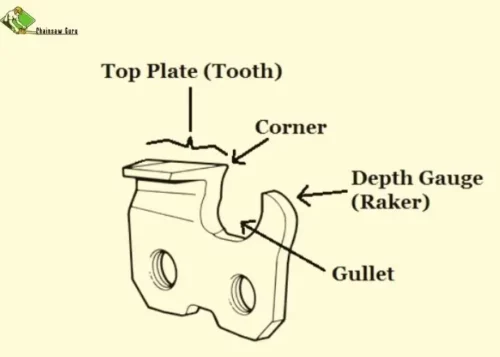 Using a chainsaw to cut down trees isn’t the most challenging task you will come across, but knowing everything about your chainsaw to keep it in prime shape is. One such thing you should know about is the chainsaw rake.
Using a chainsaw to cut down trees isn’t the most challenging task you will come across, but knowing everything about your chainsaw to keep it in prime shape is. One such thing you should know about is the chainsaw rake.
A chainsaw rake, also known as a chainsaw raker gauge, is the companion of the tooth on a chainsaw, and the two work together to produce cuts to perfection. Both are placed close to each other but have different heights, and this difference decides the size of a cut.
Now you know what a rake does, but you should also learn about its maintenance, measurement, and how to choose the best one according to your needs. Give this guide a read, and you will become an expert in this field.
What is Chainsaw Rake?
A Chainsaw Rake is the less pointed part of the chainsaw that functions with the teeth of the saw and prevents it from cutting too deeply and unevenly. Its maintenance is essential to get quality results and increase the life of your chainsaw.
How To Maintain Your Chainsaw Rakers?
You should always have a good look at the Rakers before using your chainsaw. Check for any damages or dents that might affect the cutting procedure. Sharpen your chainsaw regularly, and remember to check the height of your rakers.
Usually, the height is around the 0.025 figure, but you should always check the stamp of the chainsaw raker file to confirm it. If the height is not set correctly, you will experience a more significant recoil, and your cuts will be asymmetrical or not straight.
If you don’t maintain your rakers as mentioned above, they will wear off quickly and cost heavily on your pocket.
How To Measure Your Chainsaw Rakers?
To measure your chainsaw rakers, get a depth gauge and do the following:
- Find the chainsaw raker height from the stamp.
- Measure with a ruler to see if it’s the same height.
- Adjust the rake accordingly if there is a difference between the stamped and measured heights.
Each height profile is suitable for a specific type of wood; that’s why you should always have a depth gauge to adjust your raker’s height.
Choosing The Best Chainsaw Raker
There are many rakers in the market, and selecting the best one for yourself can be overwhelming. However, we have saved you from the hassle and listed down 3 of the best rakers for you.
- Oregon 27742 Depth Gauge Tool with Flat File
- Husqvarna 5056981-01N Depth Gauge
- Husqvarna Depth Gauge Tool For .325 Narrow Kerf Pitch Chainsaw Chain
You can choose one of the three rakers mentioned above according to your budget and cutting needs. They will last a long time, given you file them correctly and conduct frequent maintenance checks.
Related: How the Chainsaws Got Invented?
Frequently Asked Questions
Do I need to file rakers on a chainsaw every time?
Filing rakers on your chainsaw is considered necessary, and if you don’t file them down regularly, your chainsaw’s sharpness will reduce, and it will take more time to cut a regular piece of wood.
Should you run a chainsaw on full throttle?
Chainsaws are designed to run at any speed, so it doesn’t matter if you run your chainsaw at full or half throttle, especially if it has two strokes.
How many times should I sharpen my chainsaw before replacing the blades?
There is no number for how many times you should sharpen your chainsaw. After every sharp, check the quality of the cut and the kickback from the saw. If both are not satisfactory, then you should consider changing your blades.
How much time does it take to sharpen a chainsaw?
Sharpening a mini chainsaw is not a time taking task. Once you gain enough experience, you can easily sharpen it in under 15 minutes.
Final Takeaways: What is a Chainsaw Rake?
This was all you needed to know about a chainsaw rake. Hopefully, you found this guide helpful and will take proper care of your rakers from now. We would love to know your feedback and solve any queries you might encounter.
Until next time, happy cutting!
- How Thick of a Branch Can a Pole Saw Cut? - July 8, 2025
- How Many Watts Does a Pole Saw Use? - July 4, 2025
- How Long Is a Pole Saw? - July 3, 2025

